From a small bed of shrubs in the corner to brilliant multi-level features, arborvitae landscaping gives your yard its own unique personality and flair that is both beautiful and practical. With these helpful arborvitae landscaping ideas, you can transform your outdoor space into a work of art that you will be proud of. Whether you are looking to fill gaps and spaces or create an entire outdoor oasis, these tips will provide you with all the information you need to turn your visions into reality.
What looks good with Arborvitae?
When it comes to landscaping, one of the most versatile plants you can use is arborvitae. This evergreen shrub has a wealth of uses in landscapes due to its many shape variations and hardy nature. It’s also easy to maintain and care for, making it a great choice for busy homeowners who don’t have time to put into their landscape design.
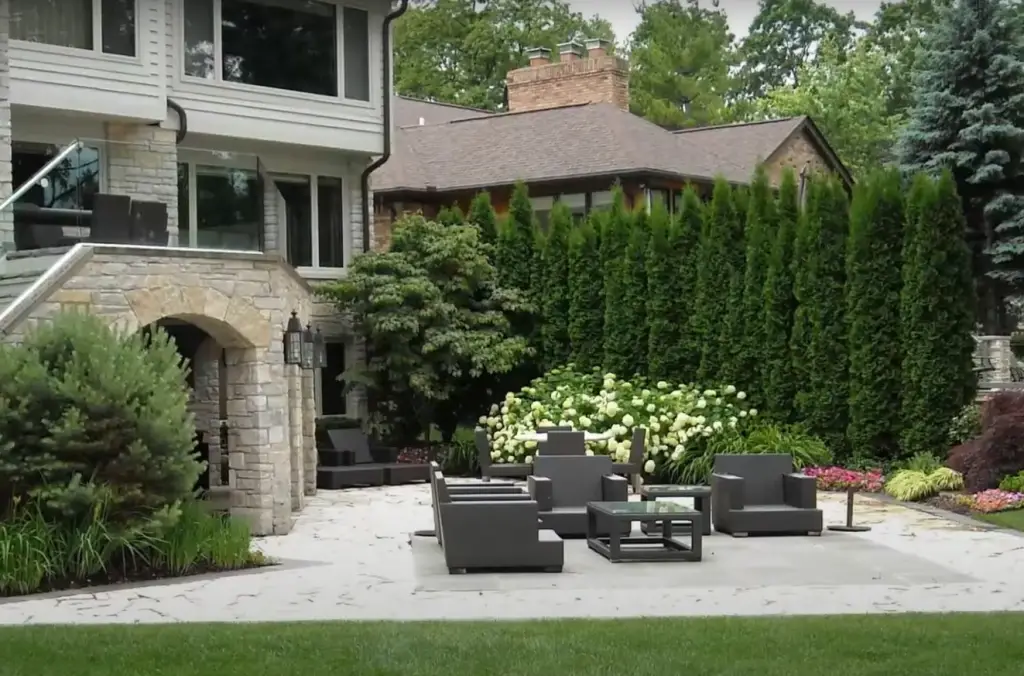
So what looks good with Arborvitae? Depending on your style preferences and the size of the area you’re looking to fill, there are plenty of options out there. Consider incorporating ornamental grasses or flowering perennials like Shasta daisy or coneflower for year-round interest in your yard. If you want a more formal look, try adding boxwoods or evergreen hedges for a classic touch. Adding an arborvitae tree with flower beds can provide a beautiful contrast between the structured lines of a hedge and the softer curves of delicate flowers. For those seeking an even more natural look, surround your arborvitae with native plants like ferns, hostas, and black-eyed susans to create a lush garden feel. [1]
What is the best arborvitae for landscaping?
When it comes to landscaping with arborvitae, you have a range of options. The most popular variety is the Emerald Green Arborvitae, which is an evergreen conifer that grows tall and narrow. It has attractive green foliage that remains vibrant all year round and can be easily pruned into different shapes. Another great choice for landscaping is the Pyramidal Arborvitae – this type grows in pyramidal shapes and produces lush green foliage that stands out from the rest of your landscape. Finally, there’s also the American Arborvitae, which has a unique wild look but still adds beauty to any landscape. All three varieties provide excellent sun and shade tolerance, plus they are low-maintenance and pest resistant. With all of these choices, you’re sure to find the perfect arborvitae for your landscaping needs!
Do arborvitae like sun or shade?
Arborvitae are trees that do best in full sun or partial shade. They can tolerate some shade but will not grow as vigorously in shady areas.
If you have a partially shaded area, make sure the arborvitae gets plenty of morning sun and is protected from the afternoon heat if possible. With adequate light, these trees will thrive and create a beautiful and lush backdrop for your garden or yard.What is the best spacing for arborvitae?
When it comes to planting arborvitae for a landscaping project, spacing is a key factor in creating an attractive and healthy garden. The general rule of thumb for spacing Arborvitae is to keep them three feet apart when planting them in rows. However, this can vary depending on the type of Arborvitae and size of your garden. For example, if you are using larger varieties or have a smaller garden area, then keeping them two feet apart may be more suitable. Additionally, if you want to create a hedge or privacy screen with your Arborvitae, then the recommended spacing would be one foot apart from each other. Keep in mind that if you plant too close together, the Arborvitae may become overcrowded and lead to thinning or balding.
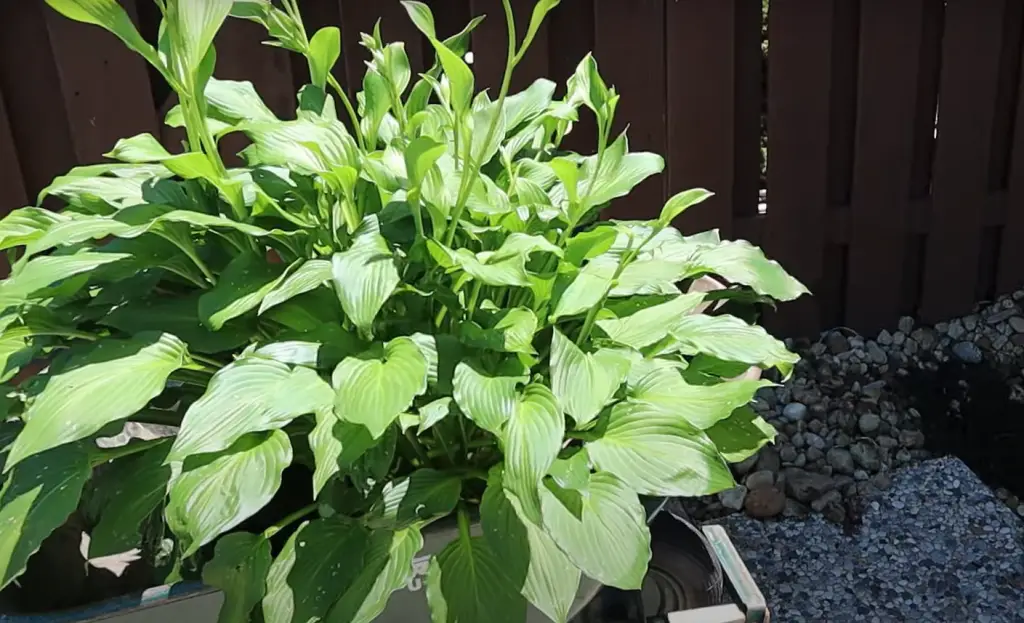
It is also important to remember that Arborvitae can grow up to 6 feet tall in some cases, so spacing them accordingly will ensure there is enough room for each plant to reach its full potential without crowding out other plants or becoming too shaded by each other. Additionally, if you are planting multiple rows of Arborvitae, then the distance between them should be half of the distance between plants within a row. For example, if the distance between two plants within a row is three feet apart, then the recommended distance between two different rows should be one-and-a-half feet apart. This helps create an even look that gives your landscape a beautiful and professional appearance. [2]
Different Ways to Landscape With Arborvitae
Arborvitae can be used in many different ways to add beauty and interest to your landscape. Here are a few ideas for how to incorporate arborvitae into your landscaping plan:
- Use them as privacy hedges – Plant several arborvitae shrubs or trees in a row to create an evergreen barrier between you and the outside world. This not only provides privacy, but also adds texture and color year-round.
- Create a living wall – Arrange multiple arborvitae shrubs or trees so that they form a living wall along one side of your property line. This will provide privacy and beauty while offering visual interest.
- Add texture with topiary – Plant arborvitae shrubs or trees in a pot or container, and prune them into unique shapes. This can add a whimsical touch to your landscape while providing privacy and greenery year-round.
- Create an outdoor room – Plant several rows of arborvitae shrubs closely together to create the walls of an outdoor “room”. Then use benches, chairs, or tables to complete the look. This will create a cozy space for you and your guests to enjoy nature without feeling exposed.
These are just a few ideas for how to incorporate arborvitae into your landscaping plan. With creative pruning, these evergreen plants can be used to create a unique and beautiful landscape that will last for years.
Conceal Your Yard With a Privacy Screen
Arborvitae are an ideal choice for creating a privacy screen in your yard. These evergreen trees can grow to 20 feet tall and make it difficult to see into your yard from the outside.
The advantage of using arborvitaes instead of installing a physical fence is that they will not only look natural but also require much less upkeep. You can use this method to hide unsightly areas or just provide yourself with some privacy from the neighbors. As an added bonus, you’ll also get the benefit of noise reduction!Block Harsh Breezes With a Windbreak
Arborvitae is a great choice for creating a windbreak. The dense, evergreen foliage provides an effective barrier to block out strong winds and harsh breezes while also providing visual interest and color. Arborvitae can be planted in rows or clusters depending on how much protection you need from the elements. Be sure to space them accordingly so that they won’t get overcrowded as they grow. When planting arborvitae, keep in mind that it will take several years before they reach their mature height of 10-15 feet. Until then, you may need to supplement with other tall shrubs or trees if you are looking for immediate protection.
Build a Sustainable Living Fence
Arborvitae shrubs are excellent for building a lush, living fence. This is an attractive way to add greenery and privacy to your landscape without having to invest in a physical barrier such as a wooden or metal fence. To create this type of fence you will need arborvitae shrubs, soil, fertilizer, and stakes. Plant the arborvitae shrubs along the perimeter of your desired area in rows two feet apart and six inches deep.
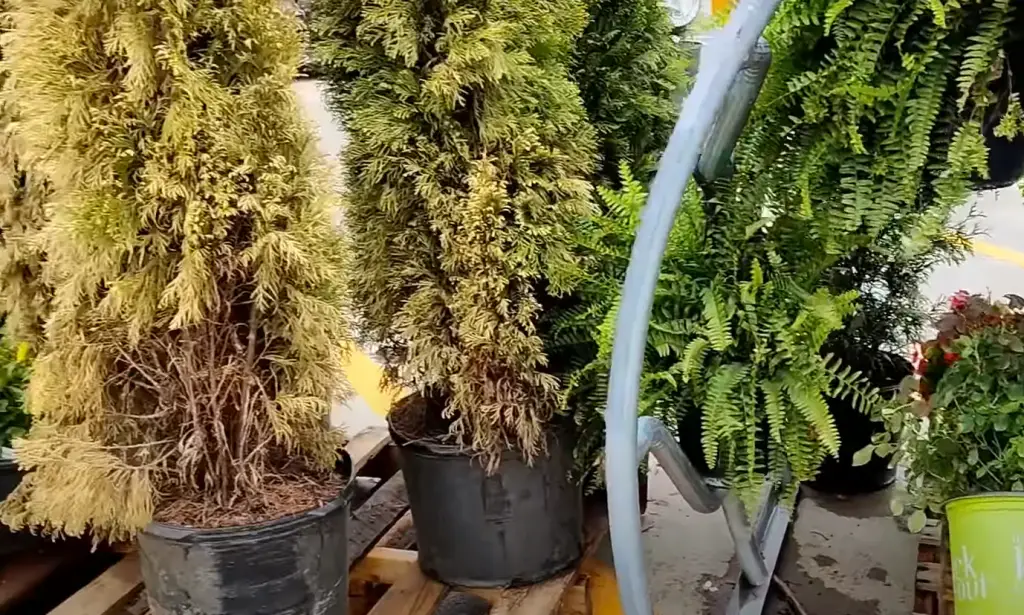
To ensure that the plants receive enough nutrients while establishing their root systems, supplement them with fertilizers spread throughout the planting area every few months. Lastly, secure each plant to a stake using twine or wire ties for extra stability until they establish themselves into the ground. With a bit of extra care and maintenance, you will be able to enjoy your living fence for years to come!
Disguise Unattractive Eyesores
Arborvitae trees are the perfect choice if you’re looking to hide an unattractive eyesore in your landscape. These evergreens can be used to block out undesirable views or act as a privacy wall between you and your neighbors. Planting arborvitae trees along property lines is also an effective way to define boundaries while adding greenery to your yard. Be sure to check local regulations, however, before planting near public areas since certain restrictions may apply.
Create Corridors or Walkways
Arborvitae is a perfect choice for creating natural-looking corridors or walkways in your outdoor space. Its lush greenery can provide both privacy and a sense of tranquility when properly planted. To create a corridor, first consider how wide you would like it to be. Once that is determined, plot out the area by marking off lines with string or stakes. Next, dig trenches along the lines about 8-12 inches deep and fill them with soil; make sure to pack down the soil firmly before planting your arborvitae trees. Planting should be done at least 4 feet apart so they have ample room to grow over time without overcrowding each other. Finally, add mulch around your trees to help retain moisture and control weeds. With some patience and care, you can create a stunning natural walkway for your backyard oasis!
Soften Fences or Other Hardscaping Elements
If your backyard has a hardscaping element such as a fence or wall, you can use arborvitaes to soften it and add some privacy. Planting an arc of them along the edge will create a natural barrier that is aesthetically pleasing while also providing some extra privacy. If you are looking for more height, consider using tall varieties of arborvitae planted in staggered rows at varying heights to create an even more dramatic effect. You can also choose from many different types of arborvitaes – from the classic green ones to variegated or yellow-tinted varieties – to find something that complements your landscaping design perfectly.
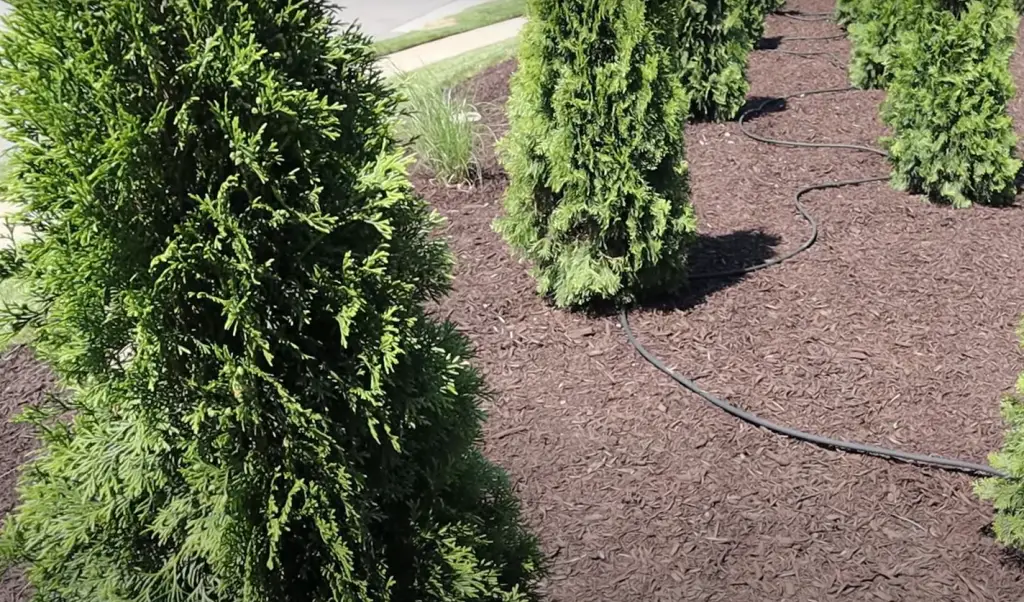
Another great way to use arborvitaes for softening a hardscaping element is to create an eye-catching topiary. This could be done by creating an archway, a hedge, or even shaping them into low walls or hedges – the possibilities are endless! You can use differently shaped arborvitaes to make these designs and add some extra texture to your landscaping.
You can also take this one step further and create striking patterns with your arborvitaes by combining different sizes and types of the plant in creative ways. With careful pruning, you can create beautiful designs that will draw attention and leave visitors in awe of your handiwork.
Mix With Other Shrubs For Contrast
Adding other shrubs into your landscape design will add a contrasting look to the arborvitae. Consider using yews, boxwoods, hollies, and junipers that can grow in similar environments as arborvitae. These plants create an interesting texture and color contrast when placed around arborvitae trees. They also provide additional foliage for your yard without overshadowing the beauty of the arborvitae trees. When selecting plants to mix with your arborvitae, make sure they are compatible regarding spacing requirements, light exposure, water needs, etc. A good rule of thumb is to choose those that like similar growing conditions as the arborvitae since it’s already established in the landscape.
Add Instant Curb Appeal to Your Front Entrance
If you’re looking to add a touch of sophistication and drama to your front entrance, consider adding an arborvitae hedge. An arborvitae is a type of evergreen tree with lush foliage and dense branches, making it an excellent choice for creating a stunning focal point for any entryway.
When planning your hedge design, keep the height and width in mind so that it serves as an effective barrier without blocking the view. You can also create interesting shapes by trimming the bushes into curves or multi-levels—depending on how formal or informal you want the look to be. Planting flowers around the base will also provide depth and vibrancy to your landscape design.
For a more contemporary look, group several arborvitae trees together at the entrance of your driveway. The evergreen foliage will provide an elegant frame for any arriving or departing car, while also providing additional privacy to your property.
Arborvitae landscaping is a great way to instantly add visual interest and depth to your front entrance. With the right design and trimming techniques, you can create gorgeous garden displays that will last all year long!
Keep Common Spaces Tidy
If you want to make the best of your arborvitae landscaping ideas, then consider how they can be used in common spaces. Arborvitae is an excellent choice for framing pathways and walkways, as it helps keep them tidy and clean. The evergreen foliage will look attractive all year round, so visitors to your property will enjoy a neat and orderly stroll along the way.

You can also use arborvitae to line a garden bed or boxwood hedge, adding an additional layer of orderliness that accents your other plants nicely.
Use these ideas to help you design the perfect outdoor environment for your home. [3]Use as a Privacy Screen
An arborvitae hedge is an ideal way to provide a natural privacy screen for your yard. These evergreens are extremely fast-growing, making them perfect for this purpose. They also kick off relatively low compared to other options, adding value to your investment. When planting multiple arborvitaes, create staggered rows with different heights and spacing to add more texture and interest to the look of the hedge. It’s also important to note that pruning is essential when creating a privacy hedge so be sure you plan accordingly when choosing plants.
Frame Your Driveway or Walkway
Arborvitae is a popular choice for framing a driveway or walkway. Not only do they provide a beautiful green backdrop to the entrance of your home, but they also offer effective protection against wind and noise. To ensure that your Arborvitaes will look their best throughout the year, be sure to prune them regularly and water them often. This will keep them in shape and looking great! You may also want to use edging materials such as brick or stone around the base of each plant to give it an extra-finished look.
Use It as a Base for Variety
By planting arborvitae around your garden, you can create a beautiful backdrop for the other landscaping elements. With its dense foliage and tall stature, it provides an elegant contrast to the flowers or shrubs planted in front of it. If you have a large yard with plenty of space, consider adding multiple layers of trees so that your landscaping has more depth. This will allow you to add variety by alternating between different sizes and shapes of arborvitae. Furthermore, you can plant trees closer together if you want to give your landscape more height without needing too much room. Whatever design elements you decide on for your yard, the tree’s evergreen nature will help bring life to any season at any time!
Experiment With Arborvitae of Different Sizes and Shapes
Arborvitae are versatile evergreen shrubs, available in different sizes and shapes. For a traditional look, you can opt for the classic Arborvitae ‘Green Giant’ that is medium to large-sized and grows thickly with very little pruning required. If you’re looking for something more modern, try dwarf varieties such as ‘Golden Globe’ or ‘North Pole.’ These smaller varieties will give your landscape an interesting texture without taking up too much space. You can also choose from pyramidal trees to create an eye-catching focal point or tall arches to define your garden space. Whatever shape or size of arborvitae you choose, make sure it fits well into your existing landscape design.
Create Topiary
Topiary is a great way to create an interesting visual effect in your garden. And what better tree to use than the versatile arborvitae? Topiary of arborvitaes can be crafted into different shapes such as animals, geometric shapes, and letters. The best part about it is that they grow quickly, so you can see the results of your hard work quite soon!

It’s not too difficult to craft topiary trees with arborvitaes but there are several things that you need to keep in mind. Firstly, make sure that you choose young plants for this purpose as mature trees cannot easily be shaped into the desired shape without sacrificing some foliage. Secondly, consider the size of the shape you’re trying to create and buy plants accordingly. Thirdly, prune the shrubs regularly to maintain their shape and overall look.
Using It as a Backdrop for Your Plants
Using arborvitae as a backdrop for other plants can be quite eye-catching and beautiful. When you choose to use them as a backdrop, make sure that the trees are of different heights so that when they mature, there is still enough variety in the landscape. For example, if you’re planting two or three varieties of arborvitae together, make sure one is taller than the others. You can also create an interesting pattern by planting several shorter ones around a taller one in order to break up the monotony and create an interesting visual effect.
When choosing what to plant in front of your arborvitaes as a backdrop, pick something that will stand out nicely against their dark green color. You can opt for bright-colored flowers such as tulips or roses for a pop of color, or you can choose to add some evergreen shrubs to create a more subtle effect. Whatever you choose, make sure that it compliments the dark green hues of your arborvitaes. With some careful planning and creativity, you’ll be able to create a beautiful backdrop from your arborvitae trees!
Playing With Different Sizes and Shapes of Arborvitae
Adding arborvitae to your landscape can be a great way to add texture, color, and beauty. Whether you’re looking for something tall and majestic or small and quaint, there are so many varieties of arborvitae to choose from!
If you want to create an interesting, eye-catching landscape design with arborvitae trees, then playing around with different sizes and shapes is key. Consider using some taller varieties as a backdrop for smaller ones in the foreground. You could also use some single-trunked specimens as focal points within your garden or yard. Hedge rows look amazing when made up of various heights of arborvitae trees.
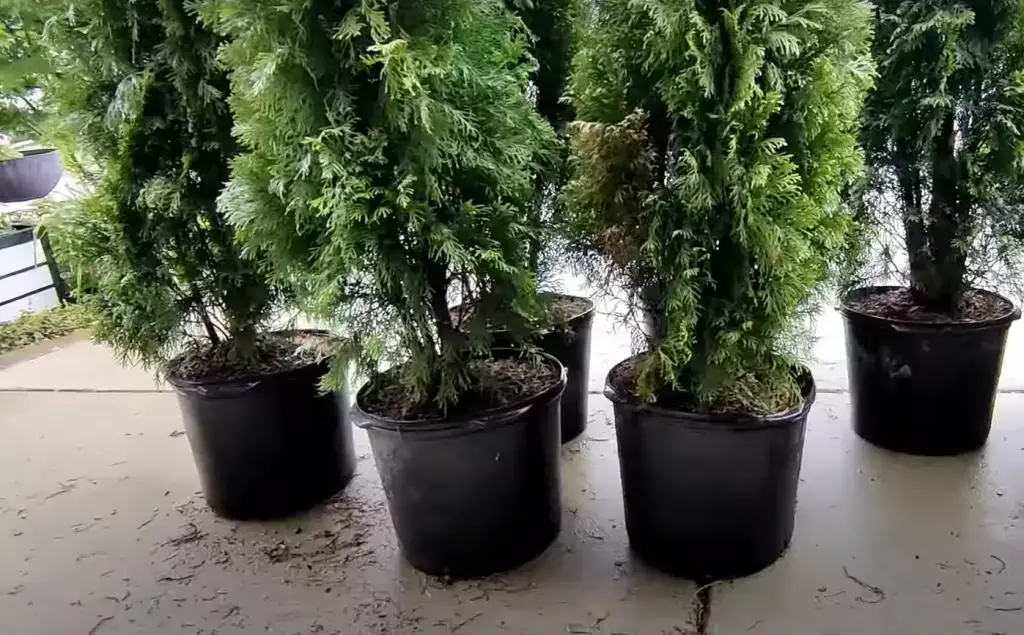
Another way to mix things up is to use different shapes of arborvitae. Many varieties are available with special features like weeping branches, twisted trunks, or unusual coloring. You can also choose rounded or pyramidal shaped varieties which can give your landscape a unique and captivating look.
Using as Windbreakers
One of the most common ways to use arborvitae in landscaping is as a windbreaker. Arborvitae are an easy way to create natural barriers around your home or garden, providing protection from gusts of wind that can damage plants and outdoor furniture. Planting several rows of arborvitaes can provide added coverage, making them ideal for reducing noise pollution and creating a more tranquil environment. Not only do they make excellent windbreakers, but these trees also look beautiful when planted in a linear fashion along a pathway or driveway. They come in various sizes and shapes, so you can easily find one that suits your needs and fits with the style of your property.
Framing Any Entryway
Arborvitae trees are a great way to frame an entryway to your home. To create a more classic look, line them up and space them evenly apart along the brick path leading up to your front door. The evergreen foliage provides year-round color, so your curb appeal will be maintained even during the winter months. For added interest, you can add colorful seasonal flowers or interesting garden art pieces near the base of each tree.
Hiding Any Unsightly Features
You may have an area of your garden that you want to hide from view. The arborvitae is the perfect choice for this job as it can be grown in a columnar shape, allowing you to use them as a hedge or screen. They are fast-growing and easy to maintain, so you can quickly achieve the desired effect. Planting taller varieties in the center and shorter ones around the edges can create an effective barrier and help mask any unsightly features that you would rather not advertise. To keep your screening looking neat, trim off any overhanging branches at least once per year. [4]
Alternatively, if you don’t mind leaving something exposed then why not use arborvitae to frame it instead? Planting them in a line on either side of a doorway or path is an easy way to create a border and can add charm to the overall look of your landscaping. For an extra touch of elegance, you could also place some topiary shrubs in between each arborvitae for added texture and interest.
FAQ
What looks good with arborvitae?
Arborvitae works well with a variety of plants, but some popular choices include low-maintenance perennials and evergreens. These can be planted around the base of the arborvitae to provide a colorful contrast to its dark green foliage.

You could also consider planting flowering shrubs such as azaleas or hydrangeas to add more color and texture to your landscape. If you’re looking for something a little more unique, try adding other conifers like juniper or pine trees for an interesting mix of greens.
What is the best arborvitae for landscaping?
When it comes to landscaping with arborvitae, the most popular choice is Thuja Green Giant. This fast-growing evergreen tree can reach heights up to 50 feet and a width of 12 feet, so it makes an impressive statement in any landscape. It has a bright green color that will stand out against other plants and trees in your yard and is extremely low maintenance once established.
Another great option for landscaping with arborvitae is Emerald Green Arborvitae. This variety grows slower than Thuja Green Giant but still makes an impact as it can reach heights of up to 30 feet tall with a width of 4-6 feet wide. Its deep emerald green foliage also provides added interest amongst other plants in your yard.
If you’re looking for something more unique, then the Dwarf Korean Arborvitae might be the right choice for you. It has an attractive pyramidal shape and can reach heights of up to 10 feet tall with a width of 3-4 feet wide. Its bright golden foliage provides a stunning contrast against its surrounding plants and trees. [5]
Do arborvitae like sun or shade?
Arborvitae are generally adaptable and can tolerate both sun and shade, although they will grow best in full sun to partial shade. They prefer 6-8 hours of direct sunlight per day for vigorous growth and vibrant color. In shadier areas, their foliage may become more yellowish-green or lime-green in hue. However, with good care, arborvitae can thrive even in very shady areas. To ensure success, it’s important to choose the right species for your climate and particular site conditions. For example, some varieties such as ‘Green Giant’ prefer full sun while others such as ‘Techny’ may do better in partial shade or a north-facing area. Additionally, pay attention to soil moisture — arborvitae like well-drained soils and may suffer if they get too much or too little water. Lastly, make sure to provide them with protection from winter winds and harsh summer sun. With the right conditions, arborvitae can be a beautiful addition to any landscape! [6]
You can consider planting companion plants around your arborvitae to add texture and color. Shrubs such as barberry, boxwood, hemlock, lilac, yew and even certain ornamental grasses can all look great planted near these stately evergreens. Perennials such as hostas, astilbes and daylilies are also good choices for adding a splash of seasonal color. Additionally, annuals can be planted in the spring and summer for an extra bit of pizzazz. The possibilities are endless — have fun exploring all the options!
What is the best spacing for arborvitae?
When planting arborvitae, it’s best to leave enough space between each plant that allows for adequate air circulation. This will help prevent the foliage from becoming diseased or infested with pests. It is also important to keep in mind how tall your arborvitae can grow so you don’t overcrowd them when they become full-grown. Generally, arborvitae should be spaced 2 to 4 feet apart. If you are planting multiple rows of arborvitae, make sure that the spacing increases as the plants get taller and wider. A good rule of thumb is to increase the spacing by at least one foot for every additional row of trees.
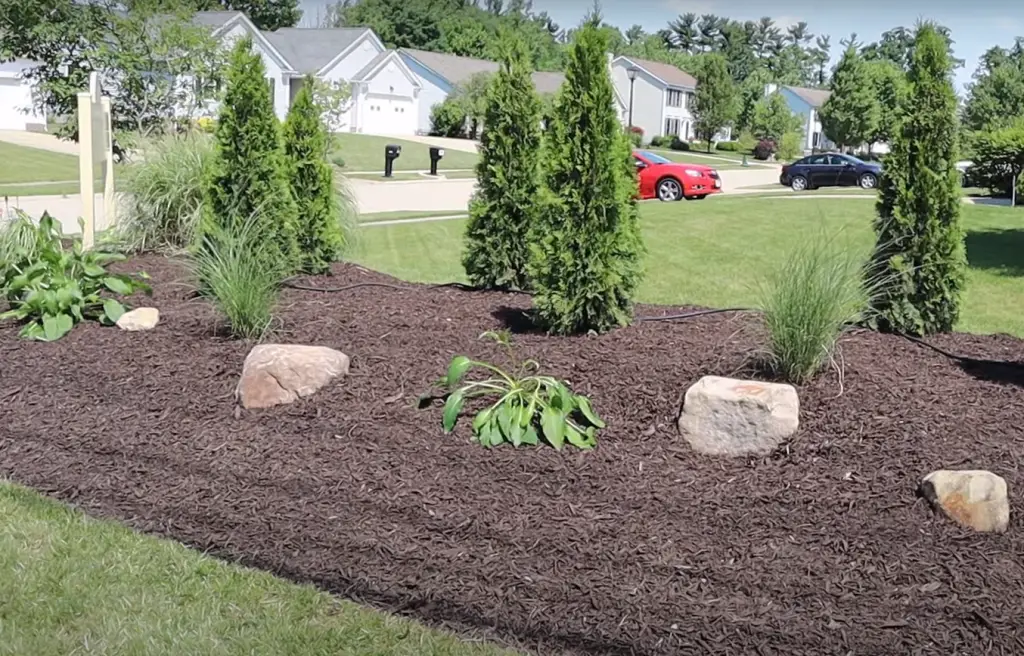
In addition to spacing your arborvitae properly, you should also make sure the soil is well-drained and won’t become waterlogged. Arborvitae does not do well in standing water or overly wet soil so be sure to choose a location with good drainage. You can improve drainage in areas that are prone to excessive moisture by amending the soil with sand or gravel before planting your arborvitae. This will help prevent root rot and other diseases from taking hold.
Finally, it’s important to position your arborvitae where they will receive at least six hours of sun each day. Without adequate sunlight, your arborvitae could struggle with growth and overall health. To ensure all of your plants get enough light, plan your landscape carefully and place taller trees in the back with shorter varieties in the front. This will allow all of your plants to receive adequate sunlight without one variety being overwhelmed by shade.
Useful Video: 10 Best Arborvitae Landscaping Ideas For An Evergreen Backyard
Conclusion
Arborvitae landscaping is a great way to create a private and secure outdoor area. Not only do these trees provide privacy, but they also look beautiful and make a perfect addition to any landscape design. Whether you choose to plant an entire hedge of Arborvitaes or just one or two as accent trees, your backyard will be sure to take on an entirely new and improved look!
For more tips and advice on creating the perfect Arborvitae landscape for your home, consult with a local landscaper. They can help guide you in choosing the right plants for your space and give expert advice on planting and caring for them. With some patience and dedication, your backyard could soon become the envy of the neighborhood! Happy landscaping!
References:
- https://gardentabs.com/what-to-plant-under-and-around-arborvitae/
- https://bowerandbranch.com/blogs/all-about-arborvitae/how-far-apart-to-plant-arborvitae-trees
- https://bustlingnest.com/arborvitae-landscaping-ideas/
- https://www.evergreenseeds.com/landscaping-with-arborvitae/
- https://www.mrtreeservices.com/blog/landscaping-with-arborvitae/
- https://www.chicagobotanic.org/plantinfo/growing_arborvitae_shade










Leave a Reply
View Comments